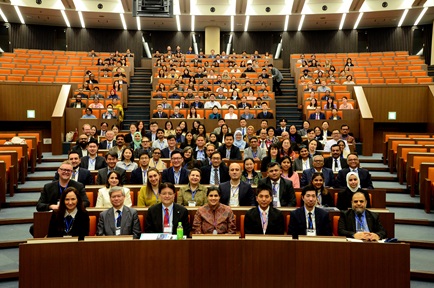Japan’s engagement with Africa shows a long-term commitment to the continent
In modern times, Japanese and African relations can be traced back to the 1960s when Japan started its official development assistance (ODA) programme to sub-Saharan Africa with the aim of promoting economic development and welfare.
By Otavio Veras

In modern times, Japanese and African relations can be traced back to the 1960s when Japan started its official development assistance (ODA) programme to sub-Saharan Africa with the aim of promoting economic development and welfare. The oil crisis in the 1970s prompted Japan to shift its strategy in Africa by developing stronger links with a wider range of nations, but keeping a focus on oil export countries such as Nigeria.
With the end of the Cold War and collapse of Soviet-sponsored states in Africa, Japan’s interest in locating strategic partners in the continent only grew. Its strategy remained fairly unchanged though, as Japan continued to use foreign aid and loans as a driver of foreign policy in Africa. From 1991 to 1997, Japan had ranked top amongst the OECD Development Assistance Committee (DAC) peers and became a leading donor for several states in Africa.
The most significant improvement in Japan-Africa relations came in 1993 with the creation of the Tokyo International Conference on African Development (TICAD). Initially organised by the government of Japan, TICAD now is co-hosted by the World Bank, United Nations Development Programme (UNDP), the African Union Commission and the United Nations.
TICAD, which happens every three years, is a multilateral forum whose participants include not only African countries, but also international organisations, partner countries, private companies and civil society organisations involved in African development. The participants have been engaged in fruitful discussions on African development, bringing together a broad range of global know-how and efforts of the international community.
Over the course of more than two decades since the first TICAD meeting in 1993, the forum built a track record of improving social and economic conditions in Africa, mainly through aid grants and technical assistance. Between 2008 and 2013, the government of Japan built 1,321 elementary and middle schools, improved 4,778 healthcare and medical facilities, and provided safe water to an additional 10.79 million people in Africa. Also, TICAD was certainly instrumental in creating the right conditions that led to the 13-fold rise in Japan’s cumulative foreign direct investment (FDI) in Africa between 2000 and 2014. During this period, FDI in the continent rose from US$758m to $10.5bn.
The triannual event was finally hosted in an African country in its sixth edition, which happened in 2016 and had over 11,000 people participating. The event gathered representatives of 53 African countries, as well as international and regional organisations, the private sector and nongovernmental organisations (NGOs). During the event, Japan’s prime minister, Shinzo Abe, announced that, between 2016 to 2018, Japan would invest $30bn on public-private partnerships in developing quality infrastructure, promoting resilient health systems and laying the foundations for peace and stability.
Japan-Africa trade
Japan’s poor natural endowment has made the country dependent on the international market for natural resources. This is observed in the trading imbalance between Japan and Africa as a whole. South Africa is Japan’s main trading partner on the continent (Figure 1). In 2017, Japan exported $7.5bn in goods to Africa, one third of it to South Africa. In the same year, Japan imported $8.3bn from Africa, from which 57% were South African goods. While most of what Japan imports from South Africa are platinum and iron ore, Japan mostly exports vehicles to South Africa.
The mineral link between Japan and South Africa was reaffirmed in February 2017, when the two countries signed an agreement on bilateral cooperation in a number of areas across the mining value chain, which includes skills development, how to decrease the environmental impact of mining and research and development in technology for the reduction of coal polluting emissions. This cooperation also fosters the development of the downstream mineral sector in South Africa by inviting Japanese companies to invest in the manufacture and beneficiation industries of that country.
The Fukushima nuclear disaster and the consequent decision to shut down most of Japan’s nuclear power generation, created a sudden demand for safer and cleaner alternatives for electricity generation in the country. Nigeria filled this gap by exporting petroleum products to Japan. The sharp increase observed in Figure 2 during 2011 and 2012 is indicative of that. Interestingly, Japan’s imports from Africa have since steadily decreased to pre-2004 levels.
Investments in energy and mining
Energy and mining are certainly the two sectors that attract most of Japanese investment in Africa. Securing multiple sources of raw material in the form of mineral resources and fuel for power generation form the core of the economic dimension of Japanese foreign policy on the continent.
In Mozambique, Mitsui, a Japanese conglomerate, holds 20% interest on the Area 1 offshore project, where the Prosperidade and Golfinho/Atum gas fields are located. The complex has recoverable natural gas reserves of 75 trillion cubic feet (Tcf) and is expected to receive final investment decision (FID) by the end of 2018. If developed, it will start producing within five years. Japanese Tohoku Electric Power agreed to buy a small share of the natural gas produced for a period of 15 years when gas starts flowing.
Japanese companies tapping oil and gas opportunities are supported by the Japan Oil, Gas and Metals National Corporation (JOGMEC). Created in 2004, JOGMEC seeks a “stable supply of natural resources to Japan”. The institution provides financial and technical support to Japanese companies in the oil and gas, and metals industries. It also engages in research and development. As part of its strategy to assure a good foundation for Japanese companies expanding business abroad, JOGMEC may offer up to 75% equity and take on up to 75% of the liability in projects during the development phase.
In 2008, it opened the Botswana Geological Remote Sensing Centre, which was established to promote cooperation with the member countries of the Southern African Development Community (SADC) and conduct rare metal exploration activities. It is also a centre for human resources development in Southern Africa, providing advanced technical training programmes in mining. In South Africa, JOGMEC also provided equity capital to acquire assets in the Samancor Chrome project, one of the largest integrated ferrochrome producers in the world.
Recently, JOGMEC transferred part of its interest in the Waterberg mining project, located in South Africa, to Japanese trading company Hanwa. The mine is expected to produce rare metals such as palladium, platinum, gold, rhodium, copper and nickel. Hanwa will secure the right to a supply of refined platinum group metals for exhaust emission catalytic converters, fuel cells for cars, and nickel and other metals for rechargeable batteries. This transaction will help keep a stable supply of these metals to Japanese high-tech industries.
Building infrastructure in Africa
Power generation and distribution
Japan is also engaged in projects in power generation and distribution in Africa, helping bring electricity to a continent where 55% of the population live in the dark. Japan International Cooperation Agency (JICA) will provide ODA to develop a 300 MW gas-turbine powerplant and transmission lines in Tanzania. The feasibility study was completed early this year and had an estimated cost of $423m, most of which was funded by JICA. The project is planned to be operational by 2020. Tanzania’s prime minister, Kassim Majaliwa, announced early in 2016 that Koyo Corporation, a Japanese energy company, is planning to build a $1bn 1,000 MW gas-fired power plant in Tanzania. In the same year, the company established an office in Dar es Salaam and initiated plans to build an assembly factory for power equipment in the city.
Japanese-backed infrastructural projects are found across most of the continent. In May 2018, JICA offered the Ugandan government a $125m loan for the construction of the Kampala Metropolitan transmission line for electricity from the yet-to-be completed 600 MW Karuma dam. Uganda is also receiving an additional $44m credit from Japan to build the New Jinja bridge, which is expected to be opened by September 2018 and will be a major link between the Northern Corridor Route and Uganda’s landlocked East African neighbours like Rwanda, Burundi and the Democratic Republic of Congo. The Northern Corridor Route is the busiest and most important transport route in East and Central Africa, providing a gateway through Kenya for Central Africa. On top of JICA’s assistance to Uganda, there is also a $26m grant for renovation, equipping and staffing of several hospitals in the country, bringing Japan’s overall development assistance to Uganda since bilateral cooperation between the two countries was established to $1.2bn.
Power Africa signed a memorandum of cooperation (MOC) with the Government of Japan in August 2016, at the TICAD VI. As part of it, Japan expects to create 1,200 MW of electricity in sub-Saharan Africa by end of 2018. The Power Africa programme was an initiative launched by former US president, Barack Obama, in 2013 to leverage private and public sector partnerships with the goal to add at least 60 million new connections to electricity in sub-Saharan Africa by 2030. The MOC also recognises the potential for geothermal power generation as a viable renewable energy source for the region and supports cross-board energy trade and regional power pools to increase access to power. In 2017, as its first transaction in support of Power Africa, Japan was instrumental in helping bring to reality the 168 MW geothermal project, Olkaria V, in Kenya. The project is on track and is expected to start operating by July 2019.
In West Africa, Japanese general trading company Marubeni signed in 2016 an MOU for the construction of a 1,800 MW $1.9bn gas-fired combined cycle powerplant in Lagos State, Nigeria. Marubeni has previously constructed a 1,320 MW conventional thermal power plant in Lagos, which is currently owned by Egbin Power. After completion, the new gas-fired combined cycle power plant will be the largest gas-fired power plant in Africa, with a capacity equal to 15% of the national total. Construction will begin in 2018, with power production to start in 2021.
Logistics integration
The Nacala Corridor is possibly the most important infrastructure project Japan is engaged in East Africa at the moment. In November 2017, Japanese Mizuho Bank, alongside Japan Bank for International Cooperation, the African Development Bank (AfDB) and nine other private financial institutions, agreed to provide $2.73bn in loans to finance the Nacala Corridor Railway and Port Project in Mozambique. The project connects the Moatize coal mine developed by Vale S.A. and Mitsui & Co, in the western Mozambican province of Tetê, to the port of Nacala, on the east coast, through a section of Malawi. Japan is totally dependent on the import of coking coal from abroad, which is used to produce steel. The corridor helps decrease supply risks related to logistics.
Additional to the railway, a deep-sea port with a capacity of 22 million tonnes per year will be built at Nacala, on the eastern end of the railway. The railway will also carry four million tones of other commodities a year, crossing Mozambique and Malawi, with a possible extension to Zambia. It will help integrate Africa and give regional farmers access to world markets.
In July 2017, JICA signed a $112m loan with Kenya’s government to improve logistics infrastructure around the port of Mombasa. The loan funds will be allocated to road and bridge public works, that will decrease traffic congestion on the access roads to the port, and to consulting services, including detailed design work, bidding assistance and construction supervision. This investment follows the completion of a new container terminal at Mombasa port in February 2016, also with support by JICA with a Japanese ODA loan.
With 1.3 million TEUs a year, the port of Mombasa leads among the East African ports in quantity of twenty-foot equivalent unit containers (TEUs) annually handled. In January 2018, Kenya’s government secured a $340m loan from Japan to increase the container handling capacity of the port. The project is due to be completed in 2022 and will include the construction of one more berth, the procurement of equipment and dredging work.
In Tanzania, JICA and the AfDB are evaluating financing part of the country’s gas distribution network. With a preliminary cost of $71m, the project aims to connect 30,000 households to the gas network and to serve about 8,000 vehicles in Dar es Salaam, the main port city in Tanzania and second-most important gateway to East Africa after Mombasa. Also in Dar es Salaam, JICA is funding the construction of the $45m Tazara flyover and proposed building additional 11 more flyovers and road links to alleviate traffic congestion in the port city. From 2010 to 2017, JICA carried out the “Capacity Building Project for the Improvement of Dar es Salaam Transport” and its second phase as technical cooperation to support the capacity-building of agencies involved with improving urban transportation. JICA is also carrying out the “Project for Revision of Dar es Salaam Urban Transport Master Plan” (2016–2018), a technical cooperation for development planning to update the urban transportation master plan through 2040, comprehensively supporting improvements to urban transportation in Dar es Salaam.
Investing in people
While Chinese infrastructural investments in Africa have at their core cost-efficient projects, the Japanese approach is said to be thorough and made-to-last. Japan also considers that developing people’s skills will help create new markets, which increases trading and ultimately benefits both Japan and the trading partner. For this principle, the country fosters a range of social works across Africa.
The African Business Education Initiative for Youth (ABE), which is based on the Japanese principle of kaizen (continuous learning), provides education and training to African foremen, plant managers, worksite leaders and 30,000 student engineers, while 1,500 business executives will receive training in Japan. The first batch of 156 African students began their degree programmes in September 2015.
One country currently benefitting from the ABE initiative is Rwanda. Japan and Rwanda are fostering particularly strong ties in information communication technology (ICT). In 2016, Rwanda’s capital, Kigali, signed an agreement with the Japanese city of Kobe to recruit over 1,000 ICT engineers from Rwanda. Under the deal, the two cities also agreed to collaborate and will exchange innovations in industries and research findings from their academic institutions. Kobe city also funded the establishment of k-Lab, an ICT incubation hub in Kigali, where a number of young Rwandan tech entrepreneurs have successfully managed to develop and sell ICT products.
Although Africa has traditionally captured a smaller proportion of Japan’s total bilateral ODA disbursements, Japan has maintained a constant presence as aid donor to the region over the past five decades, and its support has not only encompassed project financing and infrastructure development, but also humanitarian and relief assistance, technical and scientific training and support for post-conflict initiatives and peacebuilding. In 2015, for example, half a million dollars were granted to the Central Africa Republic to restore democracy in the country. In 2016, Japan granted $6.3m to emergency relief from damages in the East African region due to El Nino.
Sub-Saharan Africa received a total of $1bn in grants and $730m in loans from Japan’s ODA in 2015. While most of the ODA in Africa are used for food assistance, Japan’s assistance is also given to more specific social projects such as the construction of schools in Burkina Faso and a health science institute in Nacala and in Maputo, Mozambique. The ODAs are also applied to deeply needed social programmes, such as a programme to control the proliferation of small armies and to enhance community security in the Ivory Coast. It also included a project to help the reintegration of ex-child soldiers in the Rutshuru Territory, DR Congo.
Japan has been carrying out capacity building through the support for peacekeeping (PKO) training centres and courses in African countries as well, which includes the implementation of PKO activities in South Sudan and of anti-piracy activities off the coast of Somalia and in the Gulf of Aden. Meanwhile, hundreds of Japanese peacekeepers are in Juba, South Sudan, providing critical engineering and logistical support to United Nations peacekeeping operations. Japan’s help in airlifting equipment and supplies to South Sudan and Entebbe in Uganda, where the UN has a logistics hub, is viewed as critical to peacekeeping operations. The Asian giant is also actively coordinating with Ethiopia and other regional players to end hostilities in South Sudan.
Japan vs. China in Africa
Japan’s strategy on Africa appears to be more holistic than that of China. Japanese ODAs and projects targeting building skills and improving health and education in Africa show a long-term commitment to the continent. Japan understands its fragile position in terms of natural resources. The continuous low birth rate in Japan also counterpoints to the booming young African population. It is possible that Japan sees Africa as a partner that not only produces raw material, but also that, in the near future, will develop its primary industry sector and become a partner selling semi-finished products to Japan.
China became an unsurprising presence in Africa. Its One Belt, One Road (OBOR) initiative, a development strategy responsible for several infrastructural projects in Asia, Europe and Africa, is creating connectivity and cooperation among these regions. In May 2017, Japan and India announced a similar plan: the Asia-Africa Growth Corridor (AAGC).
Headed by Japan and India, the AAGC framework proposes the development of sea corridors linking East African ports to India and Japan, and the construction of industrial and transport infrastructure in Asia and Africa. The idea is to further integrate Africa and Asia, bypassing China and focusing on common economic interests that India, Japan and African countries share. At its conception, the initiative also involved the Jakarta-based ERIA (Economic Research Institute for ASEAN and East Asia), giving an indication that Southeast Asia’s interests will also be considered. Apart from India and Japan – South Africa, Mozambique, Indonesia, Singapore, and Australia sent representatives for the consultation process during AAGC creation planning.
Unlike OBOR, which is essentially funded by the Chinese government, AAGC intends to create ideal conditions for the private sector of the participating countries to thrive. The initiative emphasises capacity-building and expansion of the manufacturing base and trade between Africa and Asia. The idea is to transform the region into a growth corridor that will embed the development processes and value chains in Africa and Asia.
OBOR and AAGC constitute important fronts of investment in the African continent and they are not mutually exclusive. It is to the benefit of both Japan and China to be able to access African markets more easily. The works of infrastructure, capacity building and improved trading policies that each programme helps put in place, will be useful to the common goal of strengthening economic ties between Africa and Asia.
The author, Otavio Veras, is a research associate of the NTU-SBF Centre for African Studies, a trilateral platform for government, business and academia to promote knowledge and expertise on Africa, established by Nanyang Technological University and the Singapore Business Federation.
Source: How we made it in Africa, 23 August 2018







